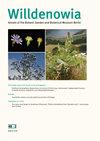A note on leaf venation and the circumscription of Tephroseris (Asteraceae–Senecioneae)
IF 1.4
3区 生物学
Q2 PLANT SCIENCES
引用次数: 2
Abstract
Molecular phylogenetic results had shown that Tephroseris, a genus differentiated from its closest relatives by its pinnately veined leaves, also contains species with palmate leaf venation. This had led to the conclusion that leaf venation is a homoplasious character in the lineage containing Tephroseris. We here take a closer look at leaf venation in Tephroseris and other species of Asteraceae–Senecioneae. We found that leaf venation in Tephroseris is distinct from leaf venation in Jacobaea vulgaris and Senecio vulgaris, which both have pinnately veined leaves as typical for most species of their respective genera, and that description of the leaves of Tephroseris as pinnately veined is incorrect. Instead, leaf venation in Tephroseris is very similar to that of upper cauline leaves of Ligularia stenocephala, a species with clearly palmately veined basal and lower cauline leaves. Both L. stenocephala and Tephroseris are part of the Ligularia–Cremanthodium–Parasenecio (L–C–P) complex. We conclude that leaf venation in Tephroseris is best regarded as derived from palmate leaf venation found in the large majority of species in the L–C–P complex, and presents no morphological obstacle to the circumscription of the genus.Citation: Kadereit J. W. & Bohley K. 2020: A note on leaf venation and the circumscription of Tephroseris (Asteraceae–Senecioneae). – Willdenowia 50: 113–117. https://doi.org/10.3372/wi.50.50111Version of record first published online on 23 March 2020 ahead of inclusion in April 2020 issue.毛茛属植物叶脉分布及界缘的研究
分子系统发育结果表明,Tephroseris是一个通过羽状叶脉与近亲分化而来的属,也包含具有掌状叶脉的物种。这导致了这样一个结论,即叶脉是包含Tephroseris的谱系中的一个同源性特征。我们在这里更仔细地观察了石龙子和菊科-千里光科的其他物种的叶脉。我们发现,Tephroseris的叶脉与Jacobaea vulgaris和Senecio vulgaries的叶脉不同,后者都有羽状脉的叶子,这是各自属大多数物种的典型特征,而将Tephroseis的叶子描述为羽状脉是不正确的。相反,Tephroseris的叶脉与狭头女贞属的上部茎生叶非常相似,狭头女贞属是一个具有明显掌状脉的基部和下部茎生叶的物种。狭头L.stenochala和Tephroseris都是女贞草-Cremanthodium-Parasenecio(L-C–P)复合体的一部分。我们得出的结论是,Tephroseris的叶脉最好被认为来源于L–C–P复合体中绝大多数物种的掌状叶脉,并且对该属的界定没有形态学障碍。引文:Kadereit J.W.和Bohley K.2020:关于Tephroseris(菊科-千里光科)的叶脉和界限的注释Willdenowia 50:113–117。https://doi.org/10.3372/wi.50.50111Version《记录》于2020年3月23日首次在线发布,随后收录在2020年4月号中。
本文章由计算机程序翻译,如有差异,请以英文原文为准。
求助全文
约1分钟内获得全文
求助全文
来源期刊

Willdenowia
PLANT SCIENCES-
CiteScore
4.60
自引率
5.30%
发文量
17
审稿时长
>12 weeks
期刊介绍:
Willdenowia is an international peer-reviewed journal publishing original research articles in English from the entire fields of plant, algal and fungal systematics, covering the evolution, taxonomy and nomenclature of these organisms as well as related fields such as floristics and plant geography. Articles on phylogeny and molecular systematics are especially welcome, as are review articles. Descriptions of new taxa may be considered, but only if supported by robust evidence. Narrowly regional studies of widespread taxa, routine typifications, checklists and new floristic records are generally not considered (excluding contributions to the Euro+Med-Checklist Notulae). Authors are encouraged to deposit duplicates of their material, especially nomenclatural types, in the Berlin herbarium (B).
 求助内容:
求助内容: 应助结果提醒方式:
应助结果提醒方式:


